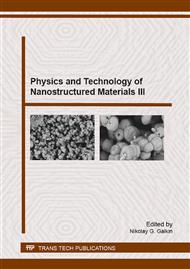[1]
G.B. Kunshina, V.I. Ivanenko, O.G. Gromov, E.P. Lokshin, Production of an electrode material modified by a lithium-conducting solid electrolyte, Russ. J. Inorg. Chem. 59 (2014) 1415–1419.
DOI: 10.1134/s003602361410009x
Google Scholar
[2]
U.K. Sen, S. Mitra, Improved electrode fabrication method to enhance performance and stability of MoS2-based lithium-ion battery anode, J. Solid State Electrochem. 18 (2014) 2701–2708.
DOI: 10.1007/s10008-014-2518-8
Google Scholar
[3]
E.V. Saenko, G.V. Leont'eva, V.V. Vol'khin, A.S. Kolyshkin, Variation of the composition and properties of lithium manganese oxide spinel in lithiation-delithiation cycles, Russ. J. Inorg. Chem. 52 (2007) 1312–1316.
DOI: 10.1134/s0036023607080256
Google Scholar
[4]
V.G. Kuryavyi, A. Yu. Ustinov, D.P. Opra, G.A. Zverev, T.A. Kaidalova, Composite containing nanosized titanium oxide and oxyfluoride and carbon synthesized in plasma of pulse high-voltage discharge, Mater. Lett. 137 (2014) 398–400.
DOI: 10.1016/j.matlet.2014.09.007
Google Scholar
[5]
B. Ebin, G. Lindbergh, S. Gurmen, Preparation and electrochemical properties of nanocrystalline LiBxMn2−xO4 cathode particles for Li-ion batteries by ultrasonic spray pyrolysis method, J. Alloy. Compd. 620 (2015) 399–406.
DOI: 10.1016/j.jallcom.2014.09.098
Google Scholar
[6]
T.L. Kulova, A.M. Skundin, Electrode materials for lithium-ion batteries of new generation, Russ. J. Electrochem. 48 (2012) 362–368.
DOI: 10.1134/s1023193512020085
Google Scholar
[7]
S.V. Gnedenkov, D.P. Opra, S.L. Sinebryukhov, V.G. Kuryavyi, А. Yu. Ustinov, V.I. Sergienko, Structural and electrochemical investigation of nanostructured C: TiO2–TiOF2 composite synthesized in plasma by an original method of pulsed high-voltage discharge, J. Alloy. Compd. 621 (2015).
DOI: 10.1016/j.jallcom.2014.10.023
Google Scholar
[8]
S.V. Makaev, V.K. Ivanov, O.S. Polezhaeva, Yu.D. Tret'yakov, T.L. Kulova, A.M. Skundin, O.A. Brylev, Electrochemical intercalation of lithium into nanocrystalline ceria, Russ. J. Inorg. Chem. 55 (2010) 991–994.
DOI: 10.1134/s0036023610070016
Google Scholar
[9]
U.K. Sen, S. Mitra, Synthesis of Molybdenum Oxides and their Electrochemical Properties against Li, Energ. Procedia. 54 (2014) 740–747.
DOI: 10.1016/j.egypro.2014.07.315
Google Scholar
[10]
P.K. Dutta, U.K. Sen, S. Mitra, Excellent electrochemical performance of tin monosulphide (SnS) as a sodium-ion battery anode, RSC Adv. 4 (2014) 43155–43159.
DOI: 10.1039/c4ra05851h
Google Scholar
[11]
T.L. Kulova, New electrode materials for lithium-ion batteries (Review), Russ. J. Electrochem. 49 (2013) 1–25.
DOI: 10.1134/s1023193513010102
Google Scholar
[12]
T. Xiao, Y. Tang, Z. Jia, S. Feng, Synthesis of SnO2/Mg2SnO4 nanoparticles and their electrochemical performance for use in Li-ion battery electrodes, Electrochim. Acta. 54 (2009) 2396–2401.
DOI: 10.1016/j.electacta.2008.10.061
Google Scholar
[13]
A.M. Skundin, O.N. Efimov, O.V. Yarmolenko, The state-of-the-art and prospects for the development of rechargeable lithium batteries, Russ. Chem. Rev. 71 (2002) 329–346.
DOI: 10.1070/rc2002v071n04abeh000706
Google Scholar
[14]
D. -A. Zhang, Q. Wang, Q. Wang, J. Sun, L. -L. Xing, X. -Y. Xue, Core–shell SnO2/TiO2–B nanowires as the anode of lithium ion battery with high capacity and ratecapability, Mater. Lett. 128 (2014) 295–298.
DOI: 10.1016/j.matlet.2014.04.160
Google Scholar
[15]
A. Hayashi, T. Konishi, K. Tadanaga, T. Minami, M. Tatsumisago, Preparation and characterization of SnO–P2O5 glasses as anode materials for lithium secondary batteries, J. Non-Cryst. Solids. 345–346 (2004) 478–483.
DOI: 10.1016/j.jnoncrysol.2004.08.069
Google Scholar
[16]
R. Liu, D. Li, D. Tian, G. Xia, C. Wang, N. Xiao, N. Li, N.H. Mack, Q. Li, G. Wu, Promotional role of B2O3 in enhancing hollow SnO2 anode performance for Li-ion batteries, J. Power Sources. 251 (2014) 279–286.
DOI: 10.1016/j.jpowsour.2013.11.068
Google Scholar
[17]
P. Lian, J. Wang, D. Cai, L. Ding, Q. Jia, H. Wang, Promotional role of B2O3 in enhancing hollow SnO2 anode performance for Li-ion batteries, Electrochim. Acta. 116 (2014) 103–110.
DOI: 10.1016/j.electacta.2013.11.007
Google Scholar
[18]
J. -H. Ahn, G.X. Wang, J. Yao, H.K. Liu, S.X. Dou, Battery dimensional changes occurring during charge/discharge cycles – thin rectangular lithium ion and polymer cells, J. Power Sources. 119–121 (2003) 45–49.
DOI: 10.1016/s0378-7753(03)00281-7
Google Scholar
[19]
A.B. Podgorbunsky, S.L. Sinebryukhov, S.V. Gnedenkov, Comparison of superionic phases for some fluorine conducting materials, Phys. Procedia. 23 (2012) 94–97.
DOI: 10.1016/j.phpro.2012.01.024
Google Scholar
[20]
L.N. Patro, K. Hariharan, Fast fluoride ion conducting materials in solid state ionics: An overview, Solid State Ionics. 239 (2013) 41–49.
DOI: 10.1016/j.ssi.2013.03.009
Google Scholar
[21]
V. Ya. Kavun, A.I. Ryabov, I.A. Telin, A.B. Podgorbunskiy, S.L. Sinebrukhov, S.V. Gnedekov, V.K. Goncharuk, Ionic mobility and conductivity in PbSnF4 doped alkali metal fluoride – obtained by NMR and Impedance spectroscopy, J. Struct. Chem. 53 (2012).
DOI: 10.1134/s0022476612020126
Google Scholar
[22]
L.L.G. Tovar, P.A. Connor, F. Belliard, L.M. Torres-Martinez, J.T.S. Irvine, Investigation of lead tin fluorides as possible negative electrodes for Li-ion batteries, J. Power Sources. 97–98 (2001) 258–261.
DOI: 10.1016/s0378-7753(01)00533-x
Google Scholar
[23]
T.L. Kulova, A.M. Skundin, Yu.E. Rogynskaya, F. Kh. Chibirova, Degradation mechanism of mixed nanostructured tin and titanium oxides when cycled, Russ. J. Electrochem. 42 (2006) 1019–1030.
DOI: 10.1134/s1023193506090011
Google Scholar
[24]
M. Martos, J. Morales, L. Sanchez, Lead-based systems as suitable anode materials for Li-ion batteries, Electrochim. Acta. 48 (2003) 615–621.
DOI: 10.1016/s0013-4686(02)00730-2
Google Scholar
[25]
O.N. Gavrilenko, E.V. Pashkova, A.G. Belous, Effect of synthesis methods on the morphology of nanosized tin dioxide particles, Russ. J. Inorg. Chem. 52 (2007) 1835–1839.
DOI: 10.1134/s0036023607120054
Google Scholar
[26]
T.L. Kulova, A.M. Skundin, Yu.E. Rogynskaya, F. Kh. Chibirova, Lithium intercalation into nanostructured films based on oxides of tin and titanium, Russ. J. Electrochem. 40 (2004) 432–439.
DOI: 10.1023/b:ruel.0000023936.13222.6f
Google Scholar
[27]
T.L. Kulova, Yu.E. Rogynskaya, A.M. Skundin, Nanostructured material based on tin and titanium oxides: A potentiodynamic study, Russ. J. Electrochem. 41 (2005) 69–74.
DOI: 10.1007/s11175-005-0054-7
Google Scholar
[28]
W. -S. Chang, C. -M. Park, H. -J. Sohn, Electrochemical performance of pyrolyzed polyacrylonitrile (PAN) based Sn/C composite anode for Li-ion batteries, J. Electroanal. Chem. 671 (2012) 67–72.
DOI: 10.1016/j.jelechem.2012.02.024
Google Scholar
[29]
S.V. Gnedenkov, D.P. Opra, S.L. Sinebryukhov, A.K. Tsvetnikov, A.Y. Ustinov, V.I. Sergienko, Hydrolysis lignin-based organic electrode material for primary lithium batteries, J. Solid State Electrochem. 17 (2013) 2611–2621.
DOI: 10.1007/s10008-013-2136-x
Google Scholar
[30]
C. Nithya, T. Sowmiya, K.V. Baskar, N. Selvaganeshan, T. Kalaiyarasi, S. Gopukumar, High capacity SnxSbyCuz composite anodes for lithium ion batteries, Solid State Sci. 19 (2013) 144–149.
DOI: 10.1016/j.solidstatesciences.2013.02.020
Google Scholar


